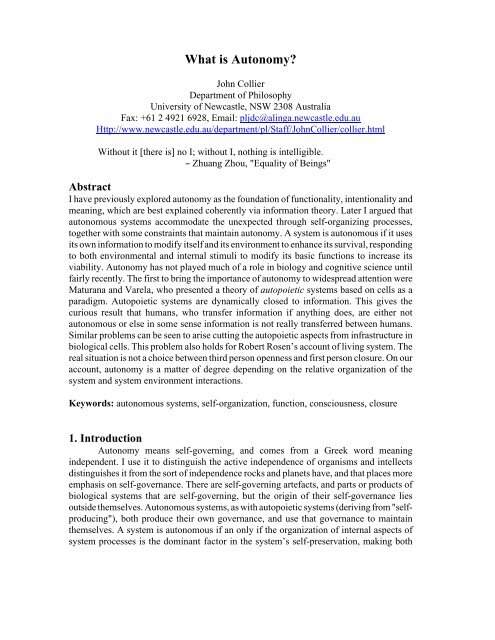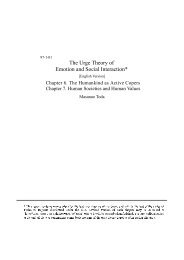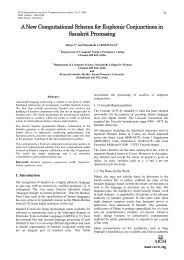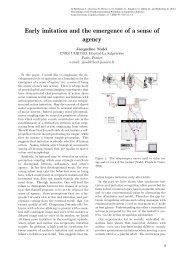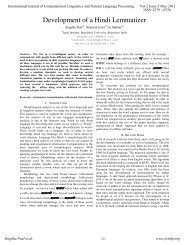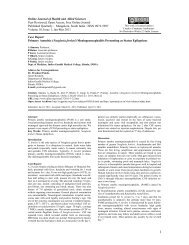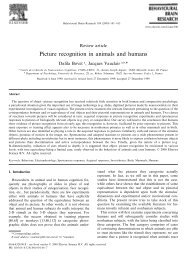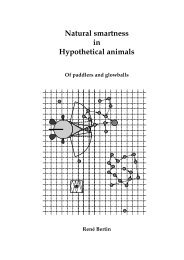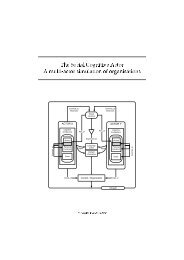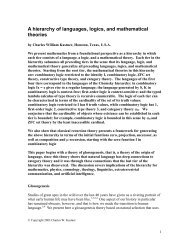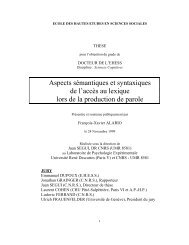What is Autonomy? - Cogprints
What is Autonomy? - Cogprints
What is Autonomy? - Cogprints
Create successful ePaper yourself
Turn your PDF publications into a flip-book with our unique Google optimized e-Paper software.
<strong>What</strong> <strong>is</strong> <strong>Autonomy</strong>?<br />
John Collier<br />
Department of Philosophy<br />
University of Newcastle, NSW 2308 Australia<br />
Fax: +61 2 4921 6928, Email: pljdc@alinga.newcastle.edu.au<br />
Http://www.newcastle.edu.au/department/pl/Staff/JohnCollier/collier.html<br />
Without it [there <strong>is</strong>] no I; without I, nothing <strong>is</strong> intelligible.<br />
% Zhuang Zhou, "Equality of Beings"<br />
Abstract<br />
I have previously explored autonomy as the foundation of functionality, intentionality and<br />
meaning, which are best explained coherently via information theory. Later I argued that<br />
autonomous systems accommodate the unexpected through self-organizing processes,<br />
together with some constraints that maintain autonomy. A system <strong>is</strong> autonomous if it uses<br />
its own information to modify itself and its environment to enhance its survival, responding<br />
to both environmental and internal stimuli to modify its basic functions to increase its<br />
viability. <strong>Autonomy</strong> has not played much of a role in biology and cognitive science until<br />
fairly recently. The first to bring the importance of autonomy to widespread attention were<br />
Maturana and Varela, who presented a theory of autopoietic systems based on cells as a<br />
paradigm. Autopoietic systems are dynamically closed to information. Th<strong>is</strong> gives the<br />
curious result that humans, who transfer information if anything does, are either not<br />
autonomous or else in some sense information <strong>is</strong> not really transferred between humans.<br />
Similar problems can be seen to ar<strong>is</strong>e cutting the autopoietic aspects from infrastructure in<br />
biological cells. Th<strong>is</strong> problem also holds for Robert Rosen’s account of living system. The<br />
real situation <strong>is</strong> not a choice between third person openness and first person closure. On our<br />
account, autonomy <strong>is</strong> a matter of degree depending on the relative organization of the<br />
system and system environment interactions.<br />
Keywords: autonomous systems, self-organization, function, consciousness, closure<br />
1. Introduction<br />
<strong>Autonomy</strong> means self-governing, and comes from a Greek word meaning<br />
independent. I use it to d<strong>is</strong>tingu<strong>is</strong>h the active independence of organ<strong>is</strong>ms and intellects<br />
d<strong>is</strong>tingu<strong>is</strong>hes it from the sort of independence rocks and planets have, and that places more<br />
emphas<strong>is</strong> on self-governance. There are self-governing artefacts, and parts or products of<br />
biological systems that are self-governing, but the origin of their self-governance lies<br />
outside themselves. Autonomous systems, as with autopoietic systems (deriving from "selfproducing"),<br />
both produce their own governance, and use that governance to maintain<br />
themselves. A system <strong>is</strong> autonomous if an only if the organization of internal aspects of<br />
system processes <strong>is</strong> the dominant factor in the system’s self-preservation, making both
itself and the processes that contribute to autonomy functional. I will clarify th<strong>is</strong> notion<br />
later with some technical details, but for now it <strong>is</strong> worth noting that autonomy <strong>is</strong><br />
organizational property constituted of process with some degree of closure, though the<br />
closure to external influences need not be complete.<br />
I will start with the following assumption that should be a necessary consequence<br />
of any sat<strong>is</strong>factory account of autonomy:<br />
HA: Normal adult humans are autonomous<br />
Note that HA <strong>is</strong> ambiguous. It might refer to biological autonomy, mental autonomy, and<br />
or emotional and psychological autonomy. The first notion we share with animals, but the<br />
others are not so clear. They may be specifically human character<strong>is</strong>tics associated with our<br />
growth and individuation into mature persons. I will not have much to say about th<strong>is</strong> here,<br />
though I have previously noted (Collier 1999) that truly intelligent robots must be mentally<br />
autonomous. I will therefore start with mental autonomy, and present some arguments for<br />
preferring a notion of mind open to the world, rather than the closed mind of<br />
computational<strong>is</strong>ts and most others currently working on the mind and consciousness.<br />
2. The Engaged Mind<br />
It <strong>is</strong> clear that autonomy requires some sort of closure, and the simplest sort of<br />
closure <strong>is</strong> complete. Sunny Auyang (2000, Chapter 2) has given an able critique of many<br />
current theories of mind that lead to a closed mind, including computational<strong>is</strong>m,<br />
connection<strong>is</strong>m, ecological theories, dynamical theories, various behavior<strong>is</strong>ms and the<br />
reverse engineering involved in evolutionary psychology. The closed mind <strong>is</strong> the dominant<br />
paradigm in both cognitive and consciousness studies, though none of the approaches l<strong>is</strong>ted<br />
above <strong>is</strong> irrevocably wedded to it. I will focus on the views of Maturana and Varela, since<br />
I believe that they are closest to being on the right track, and that much that they say <strong>is</strong> both<br />
enlightening and largely correct. Despite th<strong>is</strong>, they make a fatal methodological error that<br />
an open approach to autonomy can remedy. I hope that th<strong>is</strong> might yield some insight into<br />
how other approaches might be improved.<br />
Maturana and Varela’s approach to mind has its origins in their work on autopoies<strong>is</strong><br />
(Maturana and Varela 1980). Unlike the other theor<strong>is</strong>ts that Auyang criticizes, they focus<br />
on consciousness rather than the organized infrastructure underlying consciousness. As<br />
Auyang notes, current mind studies d<strong>is</strong>place consciousness as at best an epiphenomenon<br />
of underlying processes. Her approach <strong>is</strong> to take our common sense view of mind, and<br />
develop a theory of mind open to the world that coincides, by and large, with the common<br />
sense view. Auyang’s approach to mind involves four factors:<br />
1) Mon<strong>is</strong>m: mind <strong>is</strong> not a nonphysical entity but a kind of emergent dynamical<br />
property in certain complex physical entities.<br />
2) Infrastructure: the locus of current cognitive science <strong>is</strong> not mind as we<br />
experience it ... but in its infrastructure ... of underlying processes.<br />
3) Emergence: conscious mental processes emerge from the self-organization of<br />
many [a]conscious infrastructural processes.<br />
4) Openness: ... The subject <strong>is</strong> aware of himself only as he engages in the<br />
intelligible and social world.
Auyang does not explain either emergence or self-organization, but accepts them as<br />
legitimate scientific concepts (for an analys<strong>is</strong> of these concepts, see Collier and Hooker,<br />
1999).<br />
It <strong>is</strong> on the <strong>is</strong>sue of openness that both Auyang and our group d<strong>is</strong>agree with<br />
Maturana and Varela. The autopoietic view <strong>is</strong> a good first approximation, but it fails to<br />
account for four significant aspects of mind: 1) experience <strong>is</strong> primarily of external objects,<br />
2) knowledge of external objects and differentiation of the self <strong>is</strong> gained together through<br />
interaction with the world, 3) language <strong>is</strong> learned through both lingu<strong>is</strong>tic and non-lingu<strong>is</strong>tic<br />
social interaction, and 4) the mind <strong>is</strong> intrinsically interdependent with its supporting<br />
infrastructure, which shows up in mental fallibility in everyday life, illusions, and certain<br />
forms of brain damage. Our view of autonomy <strong>is</strong> cons<strong>is</strong>tent with 1-4, whereas autopoies<strong>is</strong><br />
says nothing about 1or 3, violates 4 in a most egregious way, and ignores the importance<br />
of specific infrastructure, especially the organizational relations between emergent<br />
consciousness and its infrastructure.<br />
Although the term autopoietic d<strong>is</strong>appears from Varela’s later work on mind (Varela<br />
et al 1991, Varela 1996a, b), Varela et al (1991) identified human experience with<br />
mindfulness, in the sense of Buddh<strong>is</strong>t meditation. Auyang accepts the importance of the<br />
phenomenon of meditation, but believes that the mind engaged in everyday activity <strong>is</strong> the<br />
more basic topic for the science of mind, since it <strong>is</strong> what most of us do most of the time.<br />
She notes that Varela and Shear point out that meditation <strong>is</strong> similar to Husserl’s<br />
phenomenological reduction (bracketing of questions of objectivity), and Varela (1996a,<br />
1996b) makes the connection explicit, adopting it as a methodology. Maturana (1988)<br />
specifically argues that phenomenological bracketing <strong>is</strong> methodologically required:<br />
In writing th<strong>is</strong> article I have followed the explanatory path of<br />
objectivity-in-parenthes<strong>is</strong>. Indeed, I could not have written it following the<br />
explanatory path of objectivity-without-parenthes<strong>is</strong>, because such an<br />
explanatory path, by negating the question about the origin of the properties<br />
of the observer as a biological entity, <strong>is</strong> constitutively blind to what I have<br />
said. (Maturana 1988)<br />
Maturana <strong>is</strong> certainly right in arguing against the negation to which he refers, but it <strong>is</strong> not<br />
clear how he avoids it himself. Though a Husserlian methodology does not imply a<br />
Husserlian mind any more than Fodor’s methodological solips<strong>is</strong>m implies that the mind <strong>is</strong><br />
solips<strong>is</strong>tic, the tendency to reflect the methodology in its object <strong>is</strong> almost irres<strong>is</strong>tible.<br />
Furthermore, Maturana’s methodological requirement explicitly violates Auyang’s fourth<br />
postulate that the mind knows itself only through the world. The phenomenological<br />
reduction brackets all questions of ex<strong>is</strong>tence and truth, and sets aside external objects and<br />
interactions with such objects. Thus it does not consider any of the four aspects of mind<br />
that Auyang considers crucial to mind science. It <strong>is</strong> a short jump from the reduction to a<br />
closed view of mind. To be fair to Varela, certain aspects of h<strong>is</strong> writing, especially<br />
references to Heidegger, and to transparency (Varela et al 1991, Varela 1996b), suggest a<br />
move towards an open mind, but the dominant view <strong>is</strong> rooted in the autopoietic cut<br />
(bracketing) that separates mind from the world. I believe that the foundations of mind
must be open from the beginning in order to explain the development of mind and self-awareness.<br />
Another problem with th<strong>is</strong> bracketing <strong>is</strong> that the mind can be implemented in<br />
anything to which it <strong>is</strong> causally <strong>is</strong>omorphic. Maturana and Varela are clear enough that the<br />
substrate of mind must be organ<strong>is</strong>mic, but there <strong>is</strong> nothing in their theory of mind as such<br />
that requires that. A John Searle and others have noted, all of the functional relations and<br />
d<strong>is</strong>tinctions in a closed mind can be embodied, say in a massive number of Chinese clerks<br />
who follow directions. Th<strong>is</strong> does not yield mindfulness, but it <strong>is</strong> not exactly clear why it<br />
does not. I think that the explanatory problem must be attacked from the other end, by<br />
seeing the mind as emergent form its infrastructure, but the phenomenological methodology<br />
does not permit th<strong>is</strong> move. Although both Maturana and Varela have emphasized the<br />
increasingly popular view of the embodied mind, Auyang points out that embodiment alone<br />
does not rule out a solips<strong>is</strong>tic mind. Engagement with the world, and interaction with the<br />
world involving mental infrastructures <strong>is</strong> required to restrict the real possibilities of<br />
embodiment.<br />
Thus there are two ways in which the phenomenological approach to mind <strong>is</strong><br />
inadequate: first, it ignores the role of external objects and our interactions with them to<br />
form mental experience and a sense of the autonomous self, and second, it ignores the<br />
importance of specific forms of infrastructure by cutting specific implementations off from<br />
mental experience. Similar objections are ra<strong>is</strong>ed by Bickhard (Bickhard 1993, Bickhard and<br />
Chr<strong>is</strong>tensen forthcoming). Bickhard calls the open mind approach interactiv<strong>is</strong>m. The<br />
closure required by autonomy <strong>is</strong> not an either/or proposition, but a matter of degree.<br />
3. Language and Engaged Mind<br />
Maturana (1988) places more emphas<strong>is</strong> on language and sociality than Varela,<br />
going so far as to claim that self-reference, indeed any reference, <strong>is</strong> possible only through<br />
language. I rather doubt th<strong>is</strong>, since children seem to be able to d<strong>is</strong>tingu<strong>is</strong>h between objects<br />
and themselves as early as four months, but confuse pronouns for "I" and "You" as late as<br />
two years. It would also imply that animals have no self-awareness, which seems to be false<br />
for at least some Great Apes on the bas<strong>is</strong> of sound evidence, and open to question in the<br />
case of many other higher animals. In any case, language <strong>is</strong> very important to the<br />
development of the human mind and of social autonomy. It can be used to demonstrate<br />
some of the aspects of openness that are permitted by our autonomy approach, but are not<br />
permitted on the autopoietic approach. As noted above, there are two difficulties, the first<br />
<strong>is</strong> openness to and dependency on external influences, and the second <strong>is</strong> dependency on<br />
infrastructure.<br />
Maturana <strong>is</strong> quite clear that language <strong>is</strong> a closed system, both within the individual<br />
and with respect to its infrastructure:<br />
An observer claims that language, or better, languaging, <strong>is</strong> taking place<br />
when he or she observes a particular kind of flow (that I shall describe<br />
below) in the interactions and co-ordinations of actions between human<br />
beings. As such, language <strong>is</strong> a biological phenomenon because it results<br />
from the operations of human beings as living systems, but it takes place in<br />
the domain of the co-ordinations of actions of the participants, and not in
their physiology or neurophysiology. Languaging and physiology take place<br />
in different and non intersecting phenomenal domains. Or, in other words,<br />
language as a special kind of operation in co-ordinations of actions requires<br />
the neurophysiology of the participants, but it <strong>is</strong> not a neurophysiological<br />
phenomenon. (Maturana 1988, italics added)<br />
Note that on th<strong>is</strong> account, language <strong>is</strong> dependent on underlying neurophysiology, but<br />
because of its independence, anything can embody language if it has the requ<strong>is</strong>ite<br />
complexity. Th<strong>is</strong> seems not to be the case, however, and for principled reasons. Chomsky’s<br />
studies of grammar, as well as neurophysiological studies, suggest that there are specific<br />
brain modules that handle the deep structure of grammar, with specific human grammars<br />
corresponding to weightings of the activation of th<strong>is</strong> module. Chomsky’s argument <strong>is</strong><br />
primarily that there are too many possible grammars to allow for learning. The most<br />
striking evidence for th<strong>is</strong> <strong>is</strong> that even intellectually deficient humans learn grammar easily,<br />
but have much more trouble than people of normal intellect in learning artificial languages.<br />
Furthermore, otherw<strong>is</strong>e intelligent people with specific brain ablations loose specific<br />
lingu<strong>is</strong>tic capacities. Apparently a specific infrastructure within the brain <strong>is</strong> required to<br />
learn language as well as to maintain lingu<strong>is</strong>tic capacities. Th<strong>is</strong> module restricts the<br />
possibilities of language, contrary to the very general account of Maturana, which suffers<br />
the same explanatory deficiency as behavior<strong>is</strong>m and the Piagetian approach to language as<br />
a function of general intelligence.<br />
Maturana goes on to say:<br />
There are circumstances in which an observer can see that under the<br />
expansion of a consensual domain of co-ordinations of actions there <strong>is</strong> a<br />
recursion in the co-ordinations of actions of the organ<strong>is</strong>ms that participate<br />
in it. When th<strong>is</strong> happens, what an observer sees <strong>is</strong>, on the one hand,<br />
organ<strong>is</strong>ms that interact with each other recurrently in consensual<br />
co-ordinations of actions, and on the other hand, a phenomenal domain in<br />
which all the phenomena that we d<strong>is</strong>tingu<strong>is</strong>h as phenomena of prax<strong>is</strong> of<br />
living in daily life take place. Due to th<strong>is</strong>, I claim that when th<strong>is</strong> occurs,<br />
language happens, and that the phenomenon of language takes place in the<br />
flow of consensual co-ordinations of consensual co-ordinations of action<br />
between organ<strong>is</strong>ms that live together in a co-ontogenic structural drift.<br />
Furthermore, I also claim that with languaging observing and the observer<br />
ar<strong>is</strong>e; the former as the second-order recursion in consensual co-ordinations<br />
of actions that constitute the phenomenon of d<strong>is</strong>tinction and the latter in a<br />
third-order in which there <strong>is</strong> the d<strong>is</strong>tinction of the operational realization of<br />
observing in a bodyhood.<br />
Maturana does not argue here that language <strong>is</strong> contained in each autonomous human, but<br />
h<strong>is</strong> coordination <strong>is</strong> ambiguous between th<strong>is</strong> possibility and the possibility of a direct<br />
transfer of information via informational interaction with others, rather than mere<br />
coordination. The autopoietic notion of autonomy requires process closure, and HA seems<br />
to rule out the direct exchange of information through linked processes a fortiori, favoring<br />
the mere coordination interpretation. However, the evidence from the learning of meanings
seems to favor the second possibility. Children do not merely attend to language in the<br />
context of everyday activity, but pay special attention to signals like glances, pointing and<br />
touching when learning words. I have already mentioned that the notion of self does not<br />
seem to require language, rasing questions about the third order requirement. Not only that,<br />
but glancing, pointing and touching seem to convey information about objects that the child<br />
uses to learn words. The concept (or at least the expectation) of a pers<strong>is</strong>tent object ar<strong>is</strong>es<br />
at about four months in most children, long before anything but babbling occurs on the<br />
lingu<strong>is</strong>tic front. Both language and the prelingu<strong>is</strong>tic mind are open to the world. Th<strong>is</strong><br />
openness appears necessary for the sort of coordination Maturana proposes. If it <strong>is</strong> not<br />
necessary, it <strong>is</strong> certainly used.<br />
I have focused on language, since it <strong>is</strong> what makes us uniquely human (so far as we<br />
know), but I could ra<strong>is</strong>e similar arguments concerning autopoietic models of perception,<br />
rationality, emotions, and, as I previously indicated, the mind in general. I do not have<br />
space here, but further arguments can be found in Auyang (2000) and in various papers at<br />
my web site and linked sites, as well as in the other bibliography cited.<br />
4. Analys<strong>is</strong> of <strong>Autonomy</strong><br />
<strong>Autonomy</strong> <strong>is</strong> both open and closed; it requires conditions that explain closure, but<br />
permit openness. Furthermore, autonomy <strong>is</strong> closely related to individuality and selfgovernance,<br />
the combination of the two yielding independent functionality through the<br />
organized interaction of processes. Varela (1979) invokes a duality between structure and<br />
organization that sets up the problems of multiple implementability that follow from the<br />
autopoietic cut. In the autonomy approach, processes and their interactions, which are<br />
themselves further processes, form the fundamental bas<strong>is</strong>, and organization <strong>is</strong> a direct<br />
property of th<strong>is</strong> network of processes. There <strong>is</strong> no duality.<br />
To analyze autonomy, I start with identity, which <strong>is</strong> based in unity. Identity <strong>is</strong> a<br />
logical or metaphysical condition that <strong>is</strong> rather trivial in that identity <strong>is</strong> fundamentally the<br />
same notion for all things. It <strong>is</strong> especially strong for dynamical objects, however. A more<br />
flexible notion <strong>is</strong> unity, which <strong>is</strong> the closure of the relations between parts of a thing that<br />
make it a whole. We can define unity as follows:<br />
If a <strong>is</strong> a component of A and for any b, b g a, aUb requires that b <strong>is</strong> also a<br />
component of A, then the logical closure of U <strong>is</strong> the unity relation of A.<br />
In the case of entities that are unified by physical processes, there <strong>is</strong> a unity relation that <strong>is</strong><br />
dynamical, or causal. Th<strong>is</strong> special case, we call cohesion. Simple examples of cohesion are<br />
a quartz crystal, in which the closure of intermolecular interactions gives the boundary of<br />
the crystal, external interactions being much weaker than internal interactions, and a gas<br />
in a box, in which the cohesion of the box defines the boundaries of the gas. Note that in<br />
each case the cohesion <strong>is</strong> not absolute; it <strong>is</strong> a matter of degree. We should expect difficult<br />
intermediate cases. Furthermore, cohesion can differ in strength in different dimensions<br />
(factors), and we really need a cohesion profile to individuate an object, but I will ignore<br />
such complexities. Cohesion both unifies a dynamical object, and d<strong>is</strong>tingu<strong>is</strong>hes it from<br />
other dynamical objects. Thus it <strong>is</strong> quite effective as a criterion of individuation. Its real<br />
strength, however, <strong>is</strong> in the way it forces us to look for dynamical closure whenever we
want to claim that something <strong>is</strong> individuated. Th<strong>is</strong> <strong>is</strong> especially significant in the case of<br />
autonomy.<br />
<strong>Autonomy</strong> <strong>is</strong> a special type of cohesion. Its d<strong>is</strong>tingu<strong>is</strong>hing feature <strong>is</strong> that cohesion<br />
<strong>is</strong> maintained actively though the contributions of component processes to the continued<br />
ex<strong>is</strong>tence of the system, either directly, or through intermediate processes. The<br />
requirements of autonomy place certain restrictions on what sort of organized system might<br />
be autonomous. It should be obvious that neither a rock nor a gas in a box are autonomous,<br />
since they are not active in any sense. To be active requires doing work. Doing work, in<br />
turn, requires the ex<strong>is</strong>tence of non-equilibrium conditions. Another reason neither a rock<br />
nor a gas in a box <strong>is</strong> autonomous <strong>is</strong> that they cannot alter their own state to respond to<br />
processes that go across their boundaries. Thus they are unable to adapt to conditions<br />
around them, and certainly not to anticipate them. In order to have th<strong>is</strong> sort of self control,<br />
a system must be internally differentiated, that <strong>is</strong>, it cannot be in a uniform steady state, but<br />
must have a number of internal states dynamically accessible. Th<strong>is</strong> requires a certain<br />
flexibility that systems whose cohesion <strong>is</strong> based in high energy differentials cannot<br />
maintain. Thus we can expect it to be character<strong>is</strong>tic of autonomous systems that energy <strong>is</strong><br />
not their primary concern, but organization of their processes so as to divert energy as<br />
suitable for their survival. It would be proper, then, to describe autonomous systems, and<br />
the degree of autonomy itself, in terms of relative organization rather than in terms of<br />
relative energies of interactions. Th<strong>is</strong> <strong>is</strong> coherent with the intuition behind autopoies<strong>is</strong> that<br />
organization of processes <strong>is</strong> most significant. Furthermore, since processes contributing to<br />
autonomous cohesion must be coordinated so as to achieve viability, we should expect<br />
autonomous systems to show hol<strong>is</strong>tic organization of a hierarchical sort in which open<br />
aspects of lower level processes are closed at higher levels. However, unlike in autopoietic<br />
systems, th<strong>is</strong> closure need never be complete. While process closure to some degree <strong>is</strong><br />
essential, there will also be interactive closure among processes, both with the internal<br />
infrastructure and the external environment. We require only that the internal<br />
organizational closure <strong>is</strong> greater than the interactive closure. Comparing degrees of<br />
organization <strong>is</strong> non-trivial. In algorithmic complexity theory, logical depth, or the number<br />
of steps required to produce a surface structure from a deep structure, <strong>is</strong> often taken as a<br />
measure of organization. Th<strong>is</strong> value, though, <strong>is</strong> difficult to compute under the best of<br />
circumstances, and often impossible. Fortunately, differences in organization are often<br />
large, and are correspondingly easy to recognize. Thus it <strong>is</strong> not impossible to pick out many<br />
autonomous systems, and even to compare their degree of autonomy, and further to<br />
compare autonomy in various respects. Th<strong>is</strong> <strong>is</strong> quite different from autopoies<strong>is</strong>, which <strong>is</strong><br />
an all or nothing, and quite ind<strong>is</strong>criminate condition (Varela 1979).<br />
In summary, autonomy requires 1) non-equilibrium conditions, 2) internal<br />
dynamical differentiation, 3) hierarchical and interactive process organization, 4)<br />
incomplete closure, 5) openness to the world, 6) openness to infrastructural inputs, 7) the<br />
ex<strong>is</strong>tence of autonomy, like any cohesion, <strong>is</strong> identical to the corresponding process closure,<br />
and <strong>is</strong> not something complementary to, or over and above, th<strong>is</strong> closure. <strong>Autonomy</strong> <strong>is</strong> thus<br />
well suited as the identity condition for Auyang’s version of mind open to the world.
5. Living Systems<br />
The value of autonomy in explaining the individuality of minds, as well as the<br />
openness of mind in terms of its integration into the world and with its infrastructure<br />
suggests that it may be able to cast similar insight onto living systems. Maturana and<br />
Varela, in their early work, clearly make autopoies<strong>is</strong> necessary and sufficient for life, and<br />
also make it completely closed (e.g., Maturana and Varela 1970, Varela 1979). In later<br />
work, however, the notion of autopoies<strong>is</strong> gradually d<strong>is</strong>appears, but as I have argued, its<br />
ghost remains. There <strong>is</strong> a similar notion in Robert Rosen’s Life Itself (1991):<br />
A material system <strong>is</strong> an organ<strong>is</strong>m iff it <strong>is</strong> closed to efficient cause. (pg 245)<br />
In th<strong>is</strong> definition, efficient cause analogous to production rules as used by Maturana and<br />
Varela, so we have a similar closure to production. The notion of efficient cause itself ar<strong>is</strong>es<br />
in Rosen’s rather complex but internally coherent d<strong>is</strong>cussion of modeling relations, and<br />
essentially requires internal modeling, as does autonomy. However, unlike autonomy, and<br />
like autopoies<strong>is</strong>, it <strong>is</strong> entirely closed. A further problem <strong>is</strong> that the notion of efficient cause<br />
ar<strong>is</strong>es out of a particular view of modeling itself, and not from general systems<br />
considerations. Whether it ex<strong>is</strong>ts other than in the eye of the beholder (or, given Rosen’s<br />
emphas<strong>is</strong> on "why" questions, perhaps one should say "inqu<strong>is</strong>itor") <strong>is</strong> problematic.<br />
Traditionally, Ar<strong>is</strong>totelean efficient causation has been associated with Modern mechanical<br />
causation, but Rosen specifically denies that living systems are mechanical. Rosen’s<br />
examples linking varieties of causation to aspect of logic are not coherent, especially in h<strong>is</strong><br />
claims of independence. Th<strong>is</strong> <strong>is</strong> not helped by the fact Ar<strong>is</strong>totle’s causes are always found<br />
in each instance of cause, and are not independent at all. Rosen’s arguments that<br />
mechanical systems must be open to efficient cause are cons<strong>is</strong>tent with how he uses the<br />
notion of efficient cause in h<strong>is</strong> graphs, but th<strong>is</strong> does not imply that living systems are closed<br />
to efficient cause, and h<strong>is</strong> graphs alone do not imply closure so much as suggest that it<br />
might be general. <strong>Autonomy</strong> requires some degree of self-modeling, and Rosen’s diagrams<br />
suggest that the modeling <strong>is</strong> closed in living systems. Even if a system <strong>is</strong> pred<strong>is</strong>posed to<br />
model itself as closed to efficient cause, however, it does not follow that it <strong>is</strong> closed to<br />
efficient cause, or that th<strong>is</strong> modeling assumption does not lead to problems, perhaps<br />
analogous to the logical circles of Descartes. It <strong>is</strong> not clear whether Rosen draws h<strong>is</strong> graphs<br />
to fit h<strong>is</strong> notion of the living, or if he defines the living so as to fit h<strong>is</strong> graphs. Given past<br />
failures in terms of closed views of both life and mind, one has to be very careful. I see no<br />
grounds for thinking that Rosen has got us any further than Descartes’ Meditations, or,<br />
indeed, Hussserl’s Cartesian Meditations, or that h<strong>is</strong> view <strong>is</strong> clearly superior as an<br />
explanation to vital<strong>is</strong>m.<br />
At least Rosen does not have problems with infrastructure; metabol<strong>is</strong>m and repair<br />
within organ<strong>is</strong>ms grounds the closure of efficient causation in material causation, and we<br />
don’t have to worry about multiple instantiability, perhaps in Chinese populations on the<br />
other side of the world. Despite th<strong>is</strong>, Rosen’s closure <strong>is</strong> complete, and does not permit the<br />
d<strong>is</strong>crimination of degree and type allowed by autonomy. For th<strong>is</strong> reason alone, I think<br />
autonomy <strong>is</strong> the preferable notion, quite side from ontological problems, or the principled<br />
empirical problems that I will now d<strong>is</strong>cuss.<br />
Maturana and Varela state:
Accordingly, an autopoietic organization constitutes a closed<br />
domain of relations specified only with respect to the autopoietic<br />
organization that these relations constitute, and, thus, it defines a ‘space’ in<br />
which it can be realized as a concrete system; a space whose dimensions are<br />
the relations of production of the components that realize it. (Maturana and<br />
Varela 1970, p. 88)<br />
It should be obvious that th<strong>is</strong> closure of autopoies<strong>is</strong> ensures autonomy in any intuitive<br />
sense. But I am sceptical that there are any organ<strong>is</strong>ms in which the autopoietic organization<br />
can be separated except in an ad hoc way from organization involving heteropoietic<br />
interactions with the environment and other organ<strong>is</strong>ms.<br />
The nature of process individuation and organization requires a deeper analys<strong>is</strong>.<br />
Dividing a complex system into parts in order to explain how it functions, unless the<br />
processes make natural unities, <strong>is</strong> somewhat artificial, and leaves part of the explanation<br />
open. One important <strong>is</strong>sue <strong>is</strong> origins. Imagine an artificially made bacterium. Our<br />
manufactured bacterium would have the same cohesion conditions as a natural one, and<br />
since the cohesion <strong>is</strong> the complex functional organization that makes up autopoies<strong>is</strong> in a<br />
natural cell (at least approximately), it would be just as autonomous as a natural cell.<br />
However, it would by definition be allopoietic (as manufactured), and its efficient cause<br />
would also be in the designer. The autonomy notion avoids the paradox that <strong>is</strong>omorphic<br />
organ<strong>is</strong>ms could one be autonomous and the other not.<br />
A second <strong>is</strong>sue involves the ex<strong>is</strong>tence of borderline and intermediate cases, such as<br />
slime mould and bacterial films. These colonies act like autonomous in many respects,<br />
involving signaling, differentiation and functional organization. However, it <strong>is</strong> not clear<br />
whether they are best called colonies or individuals. The autonomy notion predicts the<br />
possibility of such difficult cases, but the absolute nature of autopoies<strong>is</strong> and closure to<br />
efficient cause do not, and require that there be a clear cut difference. The world <strong>is</strong> not so<br />
accommodating to our desire for sharp d<strong>is</strong>tinctions.<br />
6. Conclusion<br />
I have argued that the sort of closure involved in the autopoietic and efficient cause<br />
approaches to living systems and mind has certain empirical but principled difficulties with<br />
both the possibilities of embodiment and of interaction closure with the environment.<br />
<strong>Autonomy</strong> <strong>is</strong> only partially closed, and alleviates these problems, as well as giving a<br />
unified process based approach to organization. Th<strong>is</strong> avoids the sort of dualities involved<br />
in both Rosen’s and Maturana and Varela’s approaches. Furthermore, the autonomy<br />
approach can account for borderline cases.<br />
Varela (1979) clearly bases life on the ex<strong>is</strong>tence of autopoies<strong>is</strong>. Similarly, Rosen<br />
d<strong>is</strong>tingu<strong>is</strong>hes life sharply as closed to efficient causation. Does autonomy give us a similar<br />
bas<strong>is</strong> for d<strong>is</strong>tingu<strong>is</strong>hing the living from the non-living? I don’t know. I am inclined to think<br />
not, because of the variable strength of autonomy itself. It does not give us sharp<br />
boundaries, though in most cases the boundaries are sharp enough that they do not present<br />
any special problems. With the problem of the origin of life, however, it <strong>is</strong> not clear that<br />
we should even expect a sharp boundary. Similar arguments can be made about
consciousness. Th<strong>is</strong> <strong>is</strong> perhaps philosophically unsat<strong>is</strong>fying, but I think it best to leave these<br />
questions open for the time being.<br />
References<br />
Auyang, Sunny (2000) Mind in Everyday Life and Cognitive Science. Cambridge, MA:<br />
MIT Press.<br />
Bickhard, M.H. (1993) Representational Content in Humans and Machines. Journal of<br />
Experimental and Theoretical Artificial Intelligence 5: 285-333.<br />
Chr<strong>is</strong>tensen, W.D. and Mark Bickhard (submitted) The Process Dynamics of Normative<br />
Function, Mind.<br />
Collier, John (1999) <strong>Autonomy</strong> in anticipatory systems: significance for functionality,<br />
intentionality and meaning. In: Computing Anticipatory Systems, CASYS'98 -<br />
Second International Conference, edited by D. M. Dubo<strong>is</strong>, American Institute of<br />
Physics, Woodbury, New York, AIP Conference Proceedings 465, pp. 75-81,<br />
http://www.newcastle.edu.au/department/pl/Staff/JohnCollier/papers/closure.pdf<br />
Collier, John (2000) <strong>Autonomy</strong> and Process Closure as the Bas<strong>is</strong> for Functionality.<br />
Closure: Emergent Organizations and their Dynamics, edited by Jerry L.R.<br />
Chandler and Gertrud<strong>is</strong> van de Vijver, Volume 901of the Annals of the New York<br />
A c a d e m y o f S c i e n c e : 2 8 0 - 2 9 1 ,<br />
http://www.newcastle.edu.au/department/pl/Staff/JohnCollier /papers/casys98.pdf.<br />
Collier, John (forthcoming 2004) Self-organization, Individuation and Identity. Revue<br />
Internationale de Philosophie.<br />
Collier, John and C.A. Hooker (1999) Complexly Organ<strong>is</strong>ed Dynamical Systems. Open<br />
Systems and Information Dynamics, 6: 241-302, http://www.newcastle.edu.au/<br />
department/pl/compsys/publications/Cods.pdf<br />
Maturana, H.R. (1988) Reality: the Search for Objectivity Or the Quest for A Compelling<br />
Argument. The Ir<strong>is</strong>h Journal of Psychology: 25-82.<br />
Maturana, H.R. and F. Varela (1980) Autopoies<strong>is</strong> and Cognition. Dordrecht: Reidel.<br />
Rosen, R. (1991) Life Itself. New York: Columbia University Press.<br />
Varela, F.J. (1979) The Principles of Biological <strong>Autonomy</strong>. New York: North Holland.<br />
Varela, F.J (1996a) The Specious Present: A Neurophenomenology of Time<br />
Consciousness. Naturalizing Phenomenology: Issues in Contemporary<br />
Phenomenology and Cognitive Science. Edited by Jean, Petitot, Franc<strong>is</strong>co J. Varela,<br />
Bernard Pachoud and Jean-Michel Roy. Stanford: Stanford University Press,<br />
Chapter 9, pp.266-329.<br />
Varela, F.J (1996b). Neurophenomenology : A Methodological Remedy for the Hard<br />
Problem, Journal of Consciousness Studies, J.Shear (Ed.) Special Issues on the<br />
Hard Problems.<br />
Varela, F. J., Thompson, E., and Rosch, E. (1991) The Embodied Mind: Cognitive Science<br />
and Human Experience, Cambridge, MA: MIT Press.


